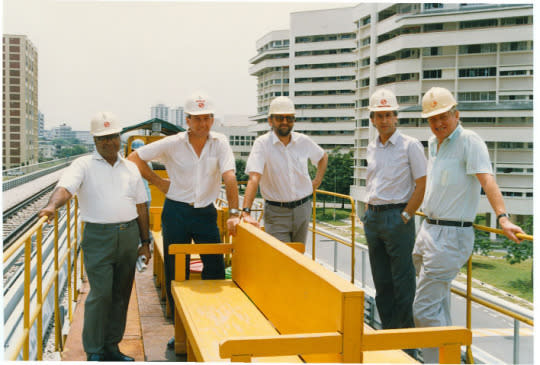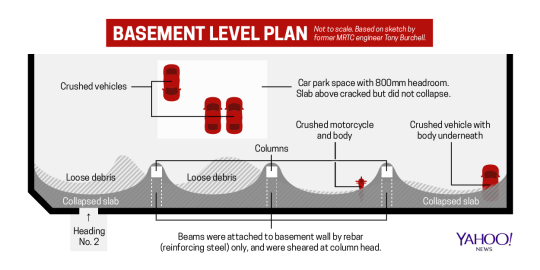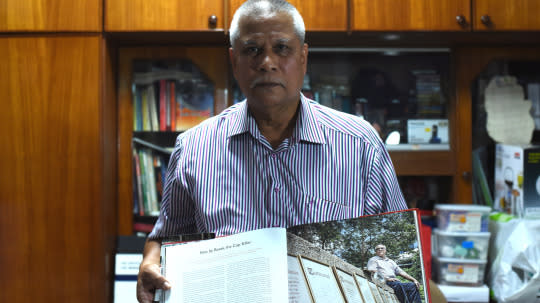Hotel New World: The men who risked their lives
A Yahoo Singapore exclusive by Nicholas Yong and Safhras Khan This is the second of a three-part series to mark the 30th anniversary of the Hotel New World disaster. Read part I and part III.
Some were members of the rescue services. Others were expatriates called upon for their unique expertise. Still others were volunteers who lent a hand simply because they could.
All of them played a part in the rescue of 17 people from the ruins of Hotel New World, after it collapsed on Saturday, 15 March, 1986.
“It’s still in my mind now,” said one rescuer, Briton Michael Scott. “I remember it very, very well. It’ll always be with me, I guess.”
Rescuers mobilised
Singer-songwriter Kelvin Tan, then 22, was a full-time National Serviceman in the final three months of his National Service. Tan went to the site with a friend over two evenings to volunteer their services.
The building contained a bank, nightclub, hotel and underground car park. But his first sight of the disaster area was “very overwhelming” said Tan. “You see all the floors crashing in, the concrete’s all falling down, and there were things caught in between. That was the surrealistic part of it – you could see cars and beds trapped in between.”
Some 500 rescue personnel from the Singapore Armed Forces, Singapore Civil Defense Force, the now-defunct Singapore Fire Service and the Singapore Police Force were eventually mobilised.
“The crowd was always there. They would bring food, drinks, towels for the rescuers. And then every time when somebody is rescued alive, you can see everybody applauding.”
- Retired policeman Abd Rahman Gulap Khan
The MRTC engineers

Former MRTC engineer Tony Burchell in 1986 (second from right). Photo courtesy of Tony Burchell
Briton Tony Burchell, then 36, was a senior resident engineer with the Mass Rapid Transit Corporation, the predecessor to Singapore Mass Rapid Transit (SMRT). Burchell and fellow engineer David Stewart mobilised a team of some 30 tunneling experts, including Michael Scott, who had been working on the MRT line.
“Not one man refused,” said Stewart, also a Briton. They spent up to 15 hours on site each day, constructing four tunnels into the debris in search of survivors. At any moment, the wreckage could have caved in and crushed them.
Burchell added, “We are used to small spaces, but it was very claustrophobic. (And) when you are dealing with a pile of rubble, it’s not like you can go away and do calculations on the load.”
“Sometimes, it was trial and error”.
‘Her name was Angelia’

On Sunday morning, at a ventilation duct that led into the car park, a member of Stewart’s team heard what sounded like a voice. He then asked for all of the equipment on site to be switched off.
Stewart said, “Once people with better hearing than me came along, they could (hear) a lady. Her name was Angelia.”
This sparked the start of an effort to try and break into the wreckage at ground level in a bid to rescue Angelia. Tunnel shift foreman Michael Scott spent many hours following the sound of her voice.
“I just kept talking to her to try and reassure her that we were going to get her out,” he said.
‘Progress was desperately slow’

Photo courtesy of The New Straits Times Press (Malaysia) Berhad
“You couldn’t use tools, because the car park was full of cars which had been squashed. There was a smell of fuel,” said Scott. Sparks from the tools could have caused a fire. There were also many obstacles in the way, from jagged steel to reinforcement bars, while the tunnels had to be reinforced with wooden beams.
“Basically, you were digging a hole to get your body through, and it was tight,” said Scott. “And as we advanced, we just kept passing everything back in a human chain. You had to literally take it out by hand.”
Other voices could also be heard. Stewart said, “They became more and more faint as time went on. They’d already been there for nearly a day.”
Suddenly, movement in the debris led to rescue personnel being evacuated from the tunnels. They waited an hour before they were allowed to go back in. But by the time the rescuers reached Angelia, it was too late.
Tunneling expert Brian Power, whom Burchell remembers as a “hard man”, struggled to accept it. “I had never seen him cry before,” said Burchell quietly.
The ever-present crowd

Retired policeman Abd Rahman Gulap Khan. Photo: Andre He/Yahoo Singapore
Retired policeman Abd Rahman Gulap Khan was a 35-year-old acting sergeant who spent a week at the site. “The crowd was always there,” said Khan of the many people gathered behind the barricades at the site throughout the day. “They would bring food, drinks, towels for the rescuers. And then every time when somebody is rescued alive, you can see everybody applauding.”
Many among the crowd were relatives of those trapped in the ruins. Stewart said, “I think one of the most difficult moments was speaking to (the relatives). They spoke very nicely and they’re obviously really hurting.”
“They didn’t know what was going to happen.”
Accounting for the dead
The grisly task of accounting for the dead fell to Khan and his team. Part of his duties included accompanying the next-of-kin to identify the 33 bodies that were recovered.
Khan, who had been working in the homicide section since 1977, recalled the task stoically, “It’s very, very sad to see them, you know. Sobbing, screaming.”
‘He was screaming like a banshee’

Retired tunnelling expert Michael Scott. Photo courtesy of Michael Scott.
Scott and SCDF personnel were able to break into the ground floor bank, where they discovered the grisly remains of a security guard – and a young man who was still alive. His foot was pinned down by a filing cabinet. As rescuers lit up the area, the survivor saw the nearby body and went into “panic mode”, said Scott.
The body was moved out of the way after several hours, but the young man did not calm down. Scott said, “Every time we tried to pull him out, he was screaming like a banshee. It was frightening, I tell you.” This went on for about an hour.
At his wits’ end, Scott requested a hacksaw in a bid to scare him. “I told him: you either keep quiet, or I’m going to cut your leg off.” Eventually, the man’s leg was freed, and he did not make a sound – although he became “hysterical” when rescuers could not retrieve his shoe.
“I went to see him in hospital later. He was still in shock, poor man. He didn’t even recognise us,” said Scott.
“It was my duty. I am not a hero.”
- Retired fireman Ramlan Dollah
On Wednesday afternoon, rescue operations were called off when it became clear that there were no more survivors.
“The decision wasn’t ours. We would have just kept going as long as there was hope,” said Stewart. “What they were saying was, people couldn’t last in that environment any longer than we’d been there.”
Scott was left to ponder if there was still a faint hope of finding anyone alive. “In your heart, you don’t want to pack up. But it does play with your mind a little bit.”
‘I don’t think I slept for a fortnight’
Did the rescuers feel any fear when they tunnelled into the debris? Not at the time, said Stewart. But he added, “There’s been many, many times when I’ve thought about it since. Perhaps we should have been more afraid. There were a few times I could wake up in a very bad sweat, thinking about it.”
Scott said, “It never crossed my mind. You just got on with it. The only thing on your mind is, you have to get people out.”
But after the rescue, Scott was haunted by the “awful smell” of death. Despite having a good bath with two bottles of Dettol, the smell lingered “for weeks”. It took five years before he fully got over the experience.
A grateful nation responds

Michael Scott (1st row, extreme left) and Ali Ismail (extreme right) at the award presentation ceremony at the Istana. Photo courtesy of Ali Ismail
A total of 94 individuals and 33 organisations involved in the rescue operations were given national awards by then-President Wee Kim Wee. They included Michael Scott, and Ramlan Dollah, a standby fireman on the day who volunteered his services.
“It was my duty. I am not a hero. I was just carrying out my duty as a fireman, to save life and protect property,” said Ramlan.
For Scott, the memories of grateful Singaporeans bring a wide smile to his face. As he got on the bus to go to work one day, the bus driver recognised Scott from seeing him on television
“He got out, and he told everyone on the bus who I was. People began to recognise me, because we’d been on TV. And I swear to God, we never moved for 20 minutes. There was pandemonium in the bus,” said Scott with a laugh.
Like Scott, Burchell also received many “little thank-you notes” from schoolchildren and adults alike. “I was amazed how the people of Singapore were so appreciative,” he said.
This is the second of a three-part series to mark the 30th anniversary of the Hotel New World disaster. Look out for part III on Tues, Mar 15. You can also read part I and part III.

